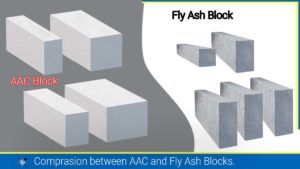Painting has never been insignificant in Bhutan. In particular, Bhutanese painting is given more importance as it deeply signifies the country’s rich culture and spiritual connectivity. The quality of paint applied to the building also indicates the wealth and pride of the owner. This article is all about Traditional Bhutanese Painting.
Traditional Bhutanese Painting
Traditional Bhutanese painting otherwise known as Lhazo is one of the 13 art of Bhutan which has been inherited from master painters by neophyte students. It is an ancient art that was mainly practised by monks in the olden days. It has gained popularity among the Bhutanese youth as the door for pursuing art is open to the common students. Traditional painting is commonly seen in scroll paintings (Thankas) and paintings of Buddhist deities on the walls of temples, dzong and buildings.

The aesthetic of Bhutanese architects is enriched with the traditional painting applied over the Bhutanese windows, doors, walls, and cornices. The paint is mainly made from natural pigment and from pigmented soil known as Saatshon. Saatshon is of different colours namely black (sa –na), red (sa-tsag) and yellow (sa-ser). Other colour pigments are made from plant matter or parts and minerals. However, due to the availability of commercial colour powder form known as Ja-tshon is substituted with the natural man-made pigment colour.
Some of the Terminology used in Bhutanese Paint
Primary colours: – Primary colours are those basic colours that cannot be obtained by mixing any other colour. These colours are Red, Yellow and Blue. In our context, it will also mean one of the Base colours.
Base Colours: – It is one of the primary colours or any of the colours obtained from mixing the primary colours, which is used as the base for the painting.
-Tshon: -The suffix “-tshon” is a synonym for the English word paint.
Fixative: -It is a thin and clear medium, which is applied over the drawing to prevent smudging such as varnish.
Hide glue: – It is glue prepared from the animal’s hide also known as animal glue.
Saa Tshon: – This term refers to traditional earth colour.
Ja-Tshon: -This refers to commercial colours available in powder form.
Types of Bhutanese Painting
The paint works are of two types as specified by the Department of Engineering Services, MoWHS. They are namely Sumdang and Dangtshon. The application of the paints is extremely specific to the nature of the structure. The residential building won’t qualify to apply the paint which is allowed to the royal court. These two varieties of paintings can be categorized into three tiers based on their quality.
Rab-Tshon: – Rab painting is the superior quality of all types of paint quality.
Ding-Tshon: – This is the intermediate quality of the paint.
Thamar-Tshon: – The lowest quality of paint is the Thamar painting.
Also, read: 5-Types of Traditional Bhutanese Windows | Best Uses

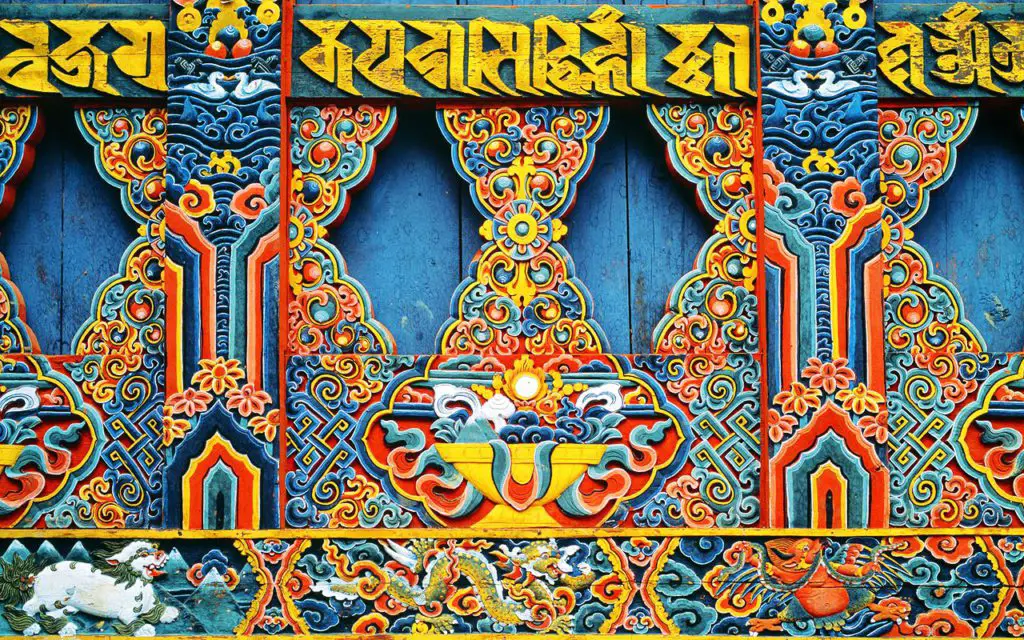
Dangtshon
Dangtshon is a technique of applying traditional painting on the walls with a gradient of a lower value to a higher value. The classification of paints is Rab, Ding, and Thamar. Any one of the classifications may be applied to the painting works. This type of paint is allowed only to be applied for external decoration for Royal cottages and internal paintings of all types of buildings.
Sumdang
This is another technique of applying traditional painting with the distinct colour shade of two or more layers. This technique is applied to paint decorative patterns such as flowers, jewels, clouds, etc. The application of Sumdang painting is as follows: –
- Rab-tshoen is restricted to painting on office buildings, Dzong and other important places;
- Ding-tshoen is applicable to institutional buildings such as schools, hospitals, etc. and
- Thamar-tshoen is only for the staff quarter and other similar buildings.
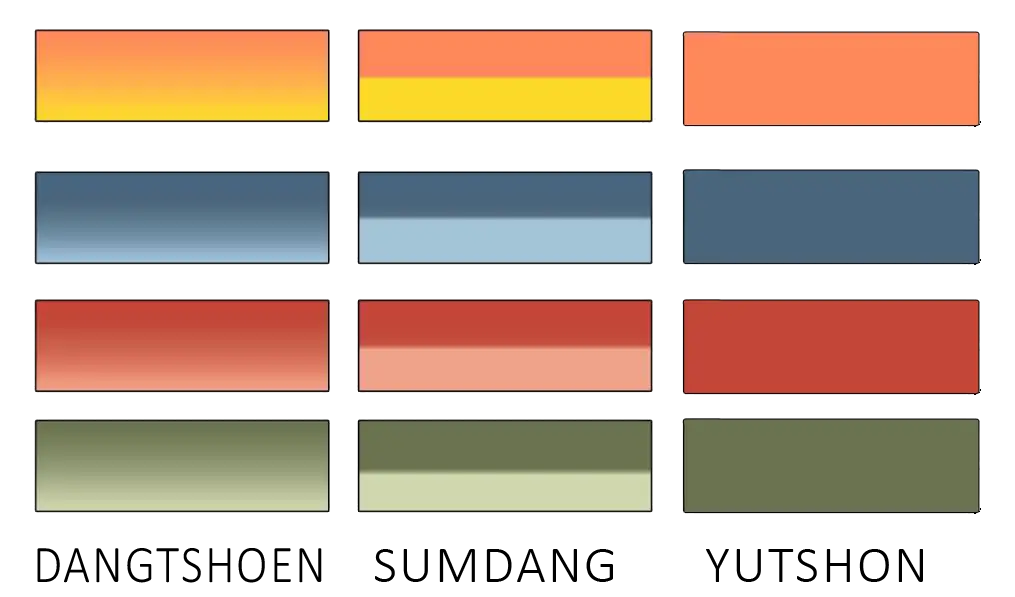
Yutshon
This is the base paint on which Sumdang and Dangtshon are applied. It is also similar to background paint. Unlike Sumdang and Dangtshon, Yutshon does not contain any colourful floral, iconographic or spiritual paintings. This paint is applied on frames of architectural elements including Janatazi (railing). Yutshon is predominately seen in the village residential buildings (houses).
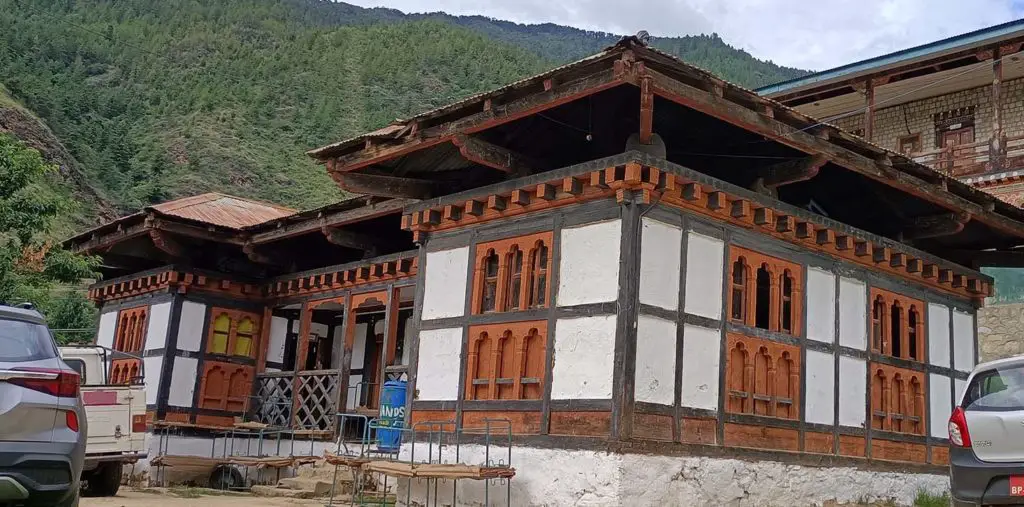
Application of Bhutanese Paint on Buildings
All building components of Bhutanese design are painted with traditional paintings of either quality. The paintings are applied on an external wall, internal partition walls, ceilings, doors, windows, architraves, etc.
External Wall Painting
Traditional buildings are painted with white, yellow or orange pigmented colour on the external wall. Sometimes red and black are painted for special buildings like local deities’ buildings and temples.
Tak (Tiger), Sang (Snow Lion), Chung (Garuda) Druk (dragon), Tashi Tagay, Tashi Zeygay, Gyeltshen Nagdhuen, and phallus are some of the paintings done on the external wall.
It is believed to bring bad luck if the external walls are painted with Methuen Namdru. Methun Namdru is the six animals image and one image is formed by the combination of two mythical animals.
Internal Wall Painting
In residential buildings, the colour used for painting is synthetic enamel paints of the desired colour in the present time. Traditional buildings or village homes are painted with mud colour of base paint.
Painting of Thuenpa Puenzhi, Tshering Drukhor, and Buddhist deities are painted on the internal wall or at the entry of the wall of the monastery and temple.
Ceiling Paintings
Traditionally, paintings on ceilings of temples, monasteries and other important buildings are painted with Mandalas. The painting is done over the base paint or decorative background as shown in figure 4.

Painting on Rabsel, Windows and Doors
Sumdang painting of all categories is applied on the opening such as doors, windows, rabsel and ventilation. Rab tshon is only done for the opening of office buildings, Dzong and temples and other important buildings.
Also, read: Types of Paints Used in Building Construction
FAQs:
-
Q: What is Traditional Bhutanese painting?
Ans: The traditional Bhutanese painting is one of the 13 art of Bhutan which is otherwise known as Lhazo. Historically, it was inherited from master painters to neophyte students. It is an ancient art that was mainly practised by monks.
-
Q: What is the classification of Bhutanese painting?
Ans: Bhutanese paintings are classified into four categories as following: –
1. Rab painting
2. Ding painting
3. Thamar painting
4. Yutshon painting -
Q: What are the types of Traditional Bhutanese painting?
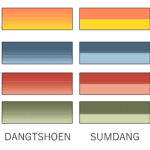
Ans: Traditional Bhutanese paintings are of two types as specified by the Department of Engineering Services, Ministry of Work and Human Settlement. They are namely Sumdang and Dangtshon. The application of the paints is extremely specific to the types of the structure.
Reference: –
- School Planning & Building Division (2004), Specifications for Bhutanese painting works
- Department of Engineering Services (2020), Specifications for Building and Road works
- Sonam Lhamo, Lhazo (painting), The Encyclopedia of Crafts in WCC-Asia Pacific Region
- Bhutanese Architectural Guideline (2014), Ministry of Work and Human Settlement
![]()





